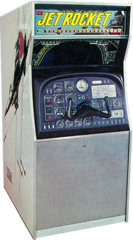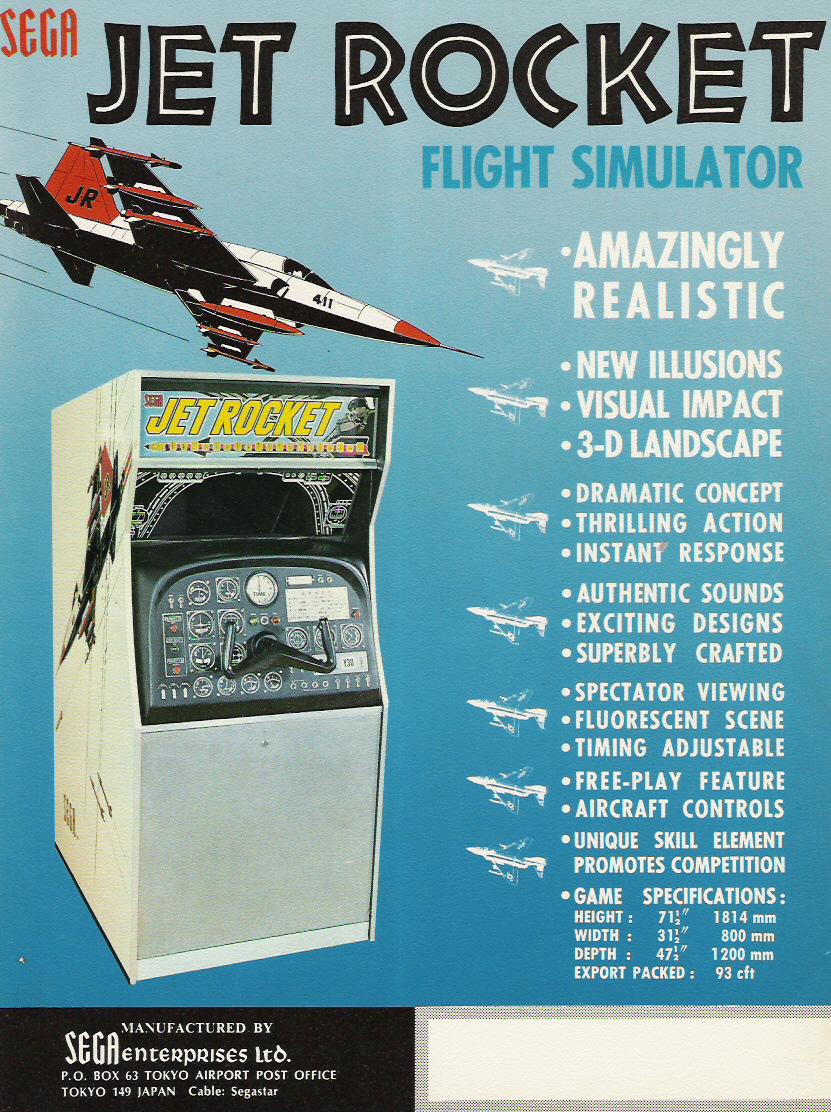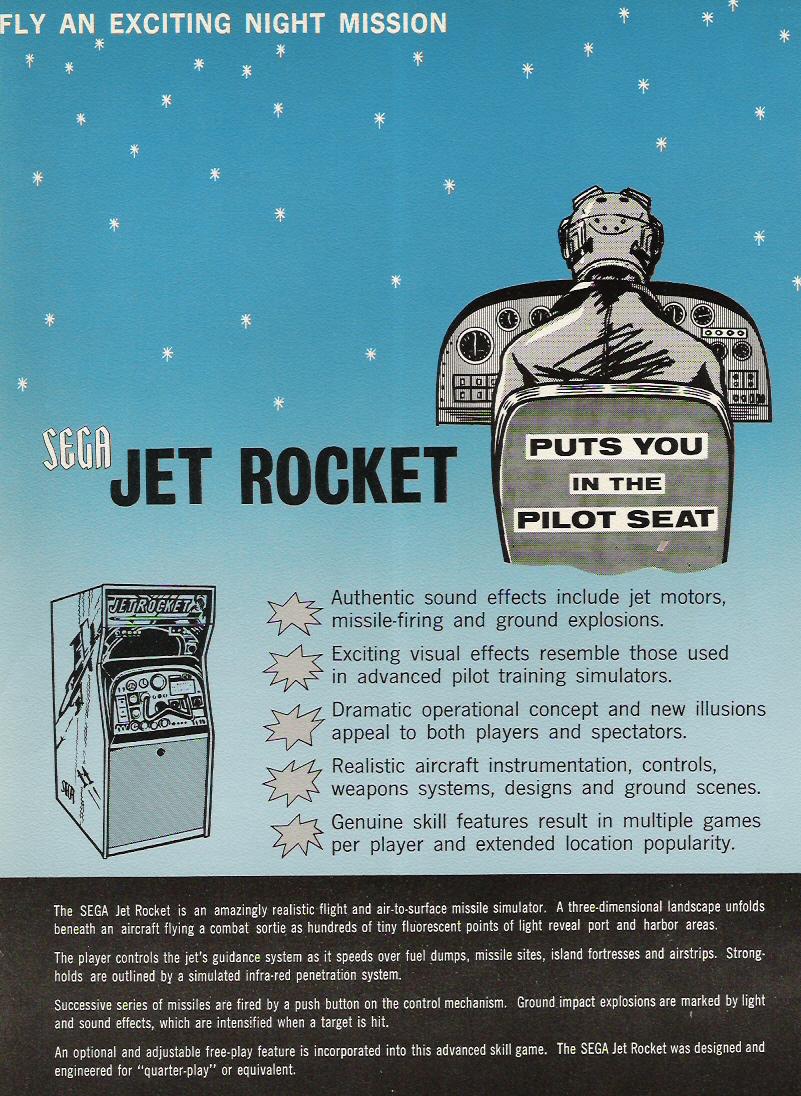Difference between revisions of "Jet Rocket"
From Sega Retro
(→Legacy) |
|||
| Line 41: | Line 41: | ||
''Jet Rocket'' was the earliest first-person flight simulator game, a genre that the game introduced to the arcade game industry, and in turn the video game industry. ''Jet Rocket'' inspired a flood of clones as soon as it released in 1970, including popular clones from three Chicago manufacturers{{ref|1=[https://books.google.co.uk/books?id=7qZhDwAAQBAJ&pg=PA14 ''The Sega Arcade Revolution: A History in 62 Games'']}} (such as ''Target Zero'' and ''Flotilla''). | ''Jet Rocket'' was the earliest first-person flight simulator game, a genre that the game introduced to the arcade game industry, and in turn the video game industry. ''Jet Rocket'' inspired a flood of clones as soon as it released in 1970, including popular clones from three Chicago manufacturers{{ref|1=[https://books.google.co.uk/books?id=7qZhDwAAQBAJ&pg=PA14 ''The Sega Arcade Revolution: A History in 62 Games'']}} (such as ''Target Zero'' and ''Flotilla''). | ||
| − | It featured shooting and flight movement in a 3D environment from a first-person perspective, like first-person vehicle combat video games such as ''Battlezone'' (1980) and ''Hovertank 3D'' (1991). This makes ''Jet Rocket'' the earliest first-person shooter, predating by many years the mid-1970s computer games ''Maze War'' and ''Spasim'',{{ref| | + | It featured shooting and flight movement in a 3D environment from a first-person perspective, like first-person vehicle combat video games such as ''Battlezone'' (1980) and ''Hovertank 3D'' (1991). This makes ''Jet Rocket'' the earliest first-person shooter, predating by many years the mid-1970s computer games ''Maze War'' and ''Spasim'',{{ref|[http://gamestudies.org/1502/articles/therrien Carl Therrien, Inspecting Video Game Historiography Through Critical Lens: Etymology of the First-Person Shooter Genre, ''Game Studies: The International Journal of Computer Game Research'', Volume 15, issue 2, December 2015, ISSN 1604-7982]}} the latter a flight simulator influenced by ''Jet Rocket''. |
The game had free-roaming flight movement over an open-ended 3D landscape, for the first time in an electronic game. It could thus be considered the first example of an [http://gaming.wikia.com/wiki/Open-world_video_games open-world] sandbox game in a rudimentary form. ''Jet Rocket'', along with its clones ''Target Zero'' and ''Flotilla'', influenced the development of free-roaming flight simulator video games such as ''Flight Simulator'' (1980), which in turn influenced open-world space flight simulators such as ''[[Elite]]'' (1984), and which in turn influenced ''[[Grand Theft Auto]]'' (1997). | The game had free-roaming flight movement over an open-ended 3D landscape, for the first time in an electronic game. It could thus be considered the first example of an [http://gaming.wikia.com/wiki/Open-world_video_games open-world] sandbox game in a rudimentary form. ''Jet Rocket'', along with its clones ''Target Zero'' and ''Flotilla'', influenced the development of free-roaming flight simulator video games such as ''Flight Simulator'' (1980), which in turn influenced open-world space flight simulators such as ''[[Elite]]'' (1984), and which in turn influenced ''[[Grand Theft Auto]]'' (1997). | ||
Revision as of 21:38, 10 November 2024

| |||||||||||||||||
| Jet Rocket | |||||||||||||||||
|---|---|---|---|---|---|---|---|---|---|---|---|---|---|---|---|---|---|
| System(s): Electro-mechanical arcade | |||||||||||||||||
| Publisher: Sega Enterprises, Ltd. | |||||||||||||||||
| Developer: Sega Production and Engineering Department | |||||||||||||||||
| Genre: Simulation | |||||||||||||||||
| Number of players: 1 | |||||||||||||||||
|
This short article is in need of work. You can help Sega Retro by adding to it.
Jet Rocket (ジェット・ロケット) is a 1970 electro-mechanical arcade flight simulator manufactured by Sega Enterprises, Ltd. The player aircraft is viewed from a first-person perspective, and the landscape and targets are displayed on a screen, using a projection display system similar to Duck Hunt, Grand Prix, Missile and Killer Shark.
It features free-roaming, first-person flight shooting gameplay. It was the first flight simulator game, a genre that it introduced to the arcade industry, where it inspired a flood of clones as soon as it released in 1970, which in turn inspired flight simulator video games. Jet Rocket was also the earliest first-person shooter (predating Maze War and Spasim), and an ancestor of open-world sandbox games (which have flight sim roots) and action-adventures.
Sega later released Heli-Shooter (1977), a similar combat flight simulator that improved on Jet Rocket with the use of a CPU processor and more sophisticated projection technology, featuring a colorful, realistic, free-roaming 3D landscape.
Contents
Gameplay
Using controls which look like that of a cockpit, the player controls the jet by joystick handle and aims rockets to intercept target areas such as fuel dumps, missile sites, island fortresses and air strips in a night mission. Pushing the firing button fires the rocket. When a target is hit, the rocket explodes and score (5 points per hit) is indicated. Ground impact explosions are marked by light and sound effects.
The cockpit controls move the player aircraft around the 3D landscape displayed on a screen and shoot missiles onto targets that explode when hit.
Specifications
Dimensions
History
Development and release
Sega Production and Engineering Department, led by Hisashi Suzuki, developed Jet Rocket in the late 1960s.[5] In 1970, it was showcased at various arcade expos in Japan and the United States. At Japan's 9th Coin Machine Show, Jet Rocket was selected as the best game of the show, out of more than 300 games showcased there.[6]
It began mass production for the Japanese market in July 1970, before receiving a worldwide release in August 1970, with Sega shipping several dozen units overseas that month due to high demand.[2] Within two months, by October, Jet Rocket was declared a "sales sensation" by Cash Box magazine.[7]
Before its wide American release in August 1970, Sega had previously sent out prototypes for testing, after which it was cloned by three Chicago manufacturers.[5] The clones included Bally's Target Zero and Williams' Flotilla, both released in December 1970. This negatively affected the game's performance in America, and temporarily put a halt to Sega's export business, before recovering later.[8]
Legacy
Jet Rocket was the earliest first-person flight simulator game, a genre that the game introduced to the arcade game industry, and in turn the video game industry. Jet Rocket inspired a flood of clones as soon as it released in 1970, including popular clones from three Chicago manufacturers[9] (such as Target Zero and Flotilla).
It featured shooting and flight movement in a 3D environment from a first-person perspective, like first-person vehicle combat video games such as Battlezone (1980) and Hovertank 3D (1991). This makes Jet Rocket the earliest first-person shooter, predating by many years the mid-1970s computer games Maze War and Spasim,[10] the latter a flight simulator influenced by Jet Rocket.
The game had free-roaming flight movement over an open-ended 3D landscape, for the first time in an electronic game. It could thus be considered the first example of an open-world sandbox game in a rudimentary form. Jet Rocket, along with its clones Target Zero and Flotilla, influenced the development of free-roaming flight simulator video games such as Flight Simulator (1980), which in turn influenced open-world space flight simulators such as Elite (1984), and which in turn influenced Grand Theft Auto (1997).
Jet Rocket could also be considered the first action-adventure game in a rudimentary form, as it combines action gameplay with a certain amount of open-world adventure exploration.
Jet Rocket was featured in a scene from the 1980 film Midnight Madness.[11]
Promotional material
Physical scans
Photo gallery
External links
- Internal operation (no English audio)
- Sega Jet Rocket: The trailblazing '70s arcade game with no computer or screen
References
- ↑ 1977 Sega Price List, page 7
- ↑ 2.0 2.1 2.2 File:CashBox US 1970-08-29.pdf, page 51
- ↑ http://thetastates.com/eremeka/1970s.html (Wayback Machine: 2023-08-19 00:30)
- ↑ File:CashBox US 1972-11-25.pdf, page 50
- ↑ 5.0 5.1 Next Generation, "December 1996" (US; 1996-11-19), page 11
- ↑ File:VendingTimes US Vol. 10 No. 12.pdf, page 32
- ↑ File:CashBox US 1970-10-31.pdf, page 58
- ↑ Next Generation, "December 1996" (US; 1996-11-19), page 12
- ↑ The Sega Arcade Revolution: A History in 62 Games
- ↑ Carl Therrien, Inspecting Video Game Historiography Through Critical Lens: Etymology of the First-Person Shooter Genre, Game Studies: The International Journal of Computer Game Research, Volume 15, issue 2, December 2015, ISSN 1604-7982
- ↑ http://www.mameworld.info/mameinfo/movies/movies2.htm







